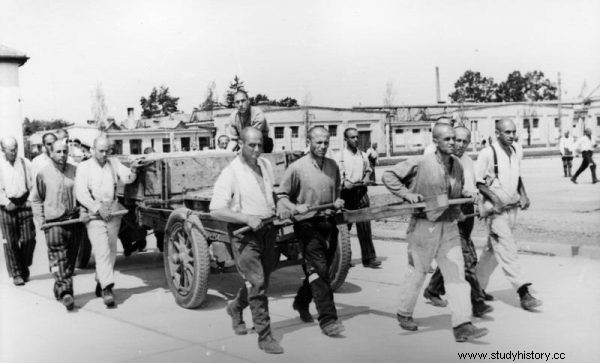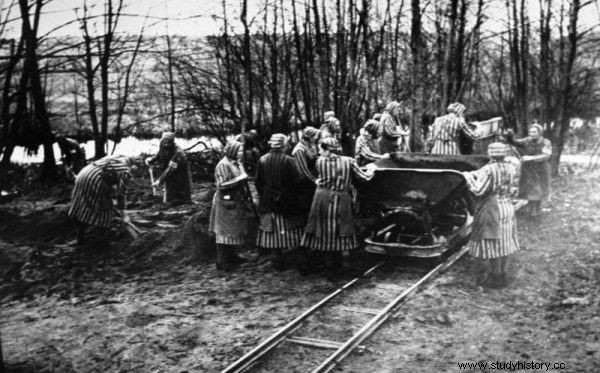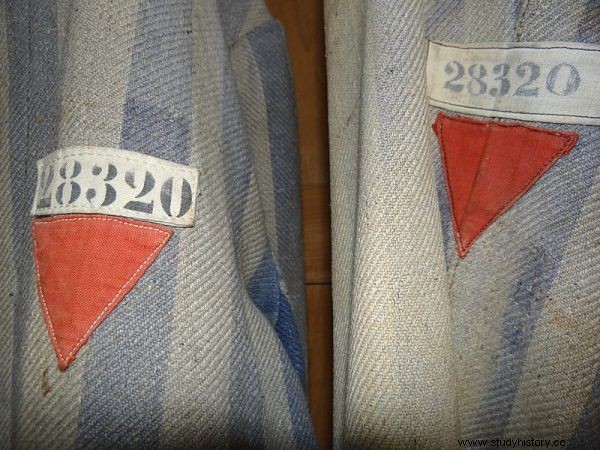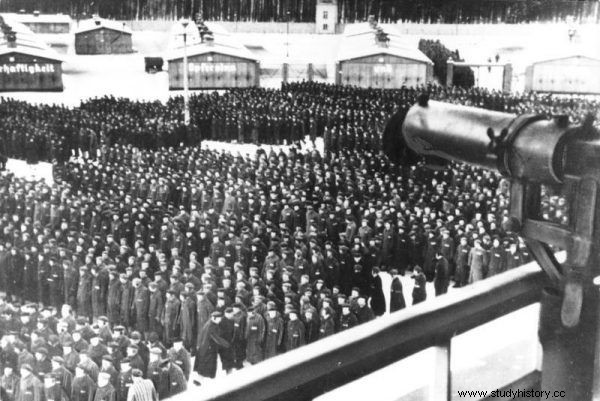In the Third Reich, even "Aryans" could not feel safe. Wrong political views, lack of enthusiasm towards the Führer, and sometimes ... glasses worn on the nose - all this could lead them to a concentration camp. What else was on the "crimes" unforgivable for the Nazis?
After taking power in Germany on January 30, 1933 (Hitler assumed the position of chancellor that day), the Nazis began to introduce their own order in the country. The real and alleged opponents of the new regime went first. Less than a month later, on February 28, the "exceptional regulation on the protection of the nation and the state" was published, drawn up by members of the NSDAP and signed by President Hindenburg. It suspended fundamental constitutional rights, including personal freedom, and granted the police enormous powers. It allowed the arrest and imprisonment of all considered enemies of the state and nation for an indefinite period of time without a court sentence .
The list of these enemies was drawn very broadly. They included members of other political options:communists, social democrats, members of the Center party, members of the Bavarian People's Party and monarchists. It also embraced journalists, writers, lawyers, Catholic and Protestant activists who were reluctant to the Nazis. Moreover, the regulation provides for the possibility of preventive arrest against enemies of the new regime, persons suspected of such hostility, and even against any person who expresses negative opinions about the state and the Führer.
Not only Jews
On the basis of the ordinance, mass arrests were carried out throughout Germany in March and April 1933. Already in the first phase, they covered about 25,000 people. Special places of isolation, called concentration camps (Konzentrationslager, KL), were organized for the detainees. Although similar establishments were known earlier (at the end of the 19th century they were created by, for example, the Spaniards in Cuba and the English in South Africa), it was the Germans who gave them a completely new, sinister face.
The first German KL was established on March 22, 1933 in Dachau, Bavaria, and became a model for other centers of this type. New camps appeared like mushrooms in various parts of Germany. In view of the large and growing number of prisoners, the demand for them was enormous. In the first months of their rule, the Nazis built at least 70 of them, including in Oranienburg, Sachsenhausen, Berlin, Papenburg, Hammerstein and Brauweiler. Prisoners were treated very brutally in these new places of detention:they were beaten, humiliated, starved and exhausted with excessive work.

Dachau - the first Nazi concentration camp.
Subsequent Lagers were established after the Anschluss of Austria. The camp in Mauthausen was then established. After the outbreak of the war, more "posts" appeared in the occupied countries:in Poland, the Soviet Union, Lithuania, Latvia and Estonia, as well as in France, the Netherlands, Denmark and Norway. Most of them were intended for the doomed Jews, but an "Aryan" could also have been sent for the wires. For many reasons.
Murderers and thieves
The criminals were usually the first ones to go to the camps. They were entrusted with the positions of functionaries (capos, room supervisors, block supervisors), they were to organize the operation of the center and keep the rest of the prisoners in check. This group included mainly those who had serious crimes on their conscience:murderers, thieves, and rapists. The functionaries were chosen to be especially cruel .
In the memoirs of many inmates, you can find descriptions of sadistic kapos or blockheads who enjoy beating, humiliating and even murdering their subordinates. Criminals were a nuisance to ordinary prisoners. As recalled by Władysław Bartoszewski, who was in Auschwitz during the war:
The first thirty Auschwitz prisoners who were initially assigned the most important positions were German criminals, degenerates. They were selected in the Sachsenhausen camp and sent to Auschwitz at the behest of commandant Rudolf Höss.
Women "too erotic"
Women practicing the oldest profession in the world were also sent to the camp. They were often used in camp brothels, known as puffas. This is how Stanisław Grzesiuk, a veteran of Nazi prisons, talked about this phenomenon in his memoirs:
Prostitutes have been brought in. Ten ages items - 8 German women, 1 Czech and 1 Polish. Cool women, smartly dressed, curled up and… you ż arte. Supposedly volunteers from the Ravensbrück concentration camp. I suppose ż e professional prostitutes. They were too wild for the women who volunteered ę , ż to save æ ż life.
Together with the prostitutes, the inmates could include ladies whose way of dressing or dressing was considered ... too provocative . The above-mentioned preventive fight against crime allowed the police to arrest female citizens with "conspicuous sexual behavior, showing up too often with different partners, with an overly erotic manner, provocatively dressed and exhibiting anti-social behavior". As can be seen, the criteria were quite broad and their application depended on the discretion of the police.
Prisoners exiled for prostitution belonged to the "anti-social" group in the camps. It was a very broad category. It included, among others, the mentally ill, drug addicts, alcoholics, pacifists, beggars, vagrants, women who had abortion forbidden in the Third Reich, lesbians, and initially also Gypsies (Roma and Sinti). Criminal prisoners were marked with green triangles, anti-social prisoners - black. As a Pole imprisoned in one of the camps recalled:
"Training" directed [was - ed. PS] by the Häftlings with green and black distinctions, known as professional criminals and idlers, who, stick in hand, taught us family fathers .

Women may have ended up in the camp for "too provocative" and "too erotic" behavior or appearance.
It was enough to be Polish (or wear glasses…)
Criminals were visible in the camps, but political prisoners outnumbered them. To hit the wires, it was enough to be recognized as an enemy by the Nazis, which - as we know - was quite easy. So there were communists, social democrats, liberals, monarchists, reluctant fascist intellectuals, writers, poets, journalists, trade unionists, Catholic and Protestant religious activists and even aristocrats in the community of the camps.
After defeating Poland, members of the intelligentsia began to be sent en masse to camps. For example, Kraków professors who were imprisoned during the Sonderaktion Krakau in November 1939 were sent there. A similar fate befell political activists, officials, military, artists, writers, and people accused or suspected of conspiratorial activity.
Sometimes, to get to the camp, it was enough to be a Pole and be caught in a street round-up. The "intellectual" appearance itself, manifested in ... wearing glasses, could also lead to the wires. This is how Władysław Bartoszewski described it:
A German soldier or gendarme was ordered to bring twenty people, intellectuals. But how the hell would you recognize people like that among pedestrians? The German stood at the corner of the street, watched and shouted:Du, Brillenträger! These are the facts, wearing glasses could really have sent a completely random man to a concentration camp .

Political prisoners were marked with a red triangle.
Political prisoners also came from France, the Czech Republic, Yugoslavia and Serbia. Usually they tried to stay together and support, and the functionaries coming from this group tried to look after the weaker prisoners. Acquaintance with one of them was recalled by Stanisław Grzesiuk:
Ernst was wi ęź Political - with a red circle. When I needed bread or margarine and Janusz didn't have him, he would send me to Ernst and he would give as much as he could. It remained until the end ń a friend of Janusz, and after the liberation he was one of the few block members who stayed with ż life. Others - bandits - wi ęź new ones smashed.
In turn, in the camp in Buchenwald, some functions of the kapo were taken by the German communists, serving their sentences since 1934. Thanks to the fight with criminal and anti-social kapos, they saved the lives of many prisoners, including Poles. It is worth emphasizing that it was among the political prisoners marked with a red triangle that the camp resistance, self-defense and resistance movement were most often born.
Priests, pastors, priests
Clergymen were also included in the same category of "red triangles". The Nazi authorities sent priests of various denominations to the camps who opposed the practices and ideology of Nazism. They also started fighting against the Catholic Church. The main place of deportation was KL Dachau, where from December 1940 priests from various camps were concentrated.

The article was inspired by the book by Edith Hahn-Beer "The Nazi's Wife. How a certain Jewish woman survived the Holocaust ” (Napoleon V 2019).
When the camp was in operation, almost 3,000 clergymen visited it. 95 percent of them were Catholic priests, most of them from Poland. Apart from them, 109 Evangelicals, 22 Orthodox Christians, 8 Old Catholics and Mariavites, and two Muslim mullahs were also held there.
Clergy also went to other centers, including KL Auschwitz-Birkenau. At least 464 priests, seminarians and religious as well as 35 nuns were imprisoned there. They came from Poland, France, the Czech Republic and Austria. Half of them lost their lives. Priests were very often treated in a similar way to Jews. Usually they were immediately referred to penal companies where the chances of survival were slim.
Jehovah's Witnesses were a particularly persecuted group. Members of this religious group opposed the cult of the Führer, the requirement of absolute obedience to the state and the far-reaching militarization of life. They also refused military service.
The activity of the movement was quickly banned, and its members became, along with the communists, one of the first concentration camp prisoners. They went to Dachau, Buchenwald, Flossenbürg, Mauthausen, Neuengamme, Niederhagen, Ravensbrück, Sachsenhausen and Auschwitz. As a result of the campaigns, over 2.8 thousand representatives of this religion were sent to labor camps. They were distinguished by their strong faith and steadfast attitude.
Pink triangles
People were also sent to the concentration camp for homosexuality. It was banned in Germany, and the Nazis exterminated it with particular commitment. Not only were male-male sexual relations punished, but even the mere suspicion of them. Between 1933 and 1945, over 100,000 people were arrested for this reason. It is estimated that between 10,000 and 15,000 were sent to concentration camps, and 60 percent of them died there.

Thousands of prisoners were sent to the camps. For all sorts of reasons… Pictured are Sachsenhausen prisoners.
Homosexuals were treated worse than other prisoners, both by the guards and other inmates. Theoretically, they wanted to "rehabilitate" and "cure" them of homosexuality, for example by forced visits to the camp brothel and intercourse with women. In practice, efforts were made to simply destroy them . Gay men in the camps were marked with a pink triangle. Interestingly, homosexual women were ranked separately - they were included in the group of anti-social prisoners wearing black triangles.
Gypsies were also sent to the camps, just like the Jews doomed to destruction. There were Soviet and Italian prisoners of war, important politicians or servicemen from the occupied countries (for example, Stepan Bandera or General Stefan Grot-Rowecki), participants of the anti-Nazi opposition and members of their families. There was really not much else to do to go to Hell.
Inspiration:
The article was inspired by the book by Edith Hahn-Beer "The Nazi's Wife. How a certain Jewish woman survived the Holocaust ” (Napoleon V 2019), whose heroine, hiding in the heart of the Third Reich, watched how little it took for the people around her to disappear from her life forever ...
Bibliography:
- Władysław Bartoszewski, My Auschwitz , Mark 2010.
- Stanisław Grzesiuk, Five years of the camp , Book and Knowledge 1997.
- I'm alive. Choosing the answer to the questionnaire by Fr. prof. Konstanty Michalski from 1945, addressed to former political prisoners during the German occupation , Publishing House of the Theological Institute of Missionaries 2012.
- Mike Urbaniak, Joanna Ostrowska, The Cursed Boys. There were 122 prisoners in Auschwitz with pink triangles , Gazeta.pl (access:February 5, 2019).
